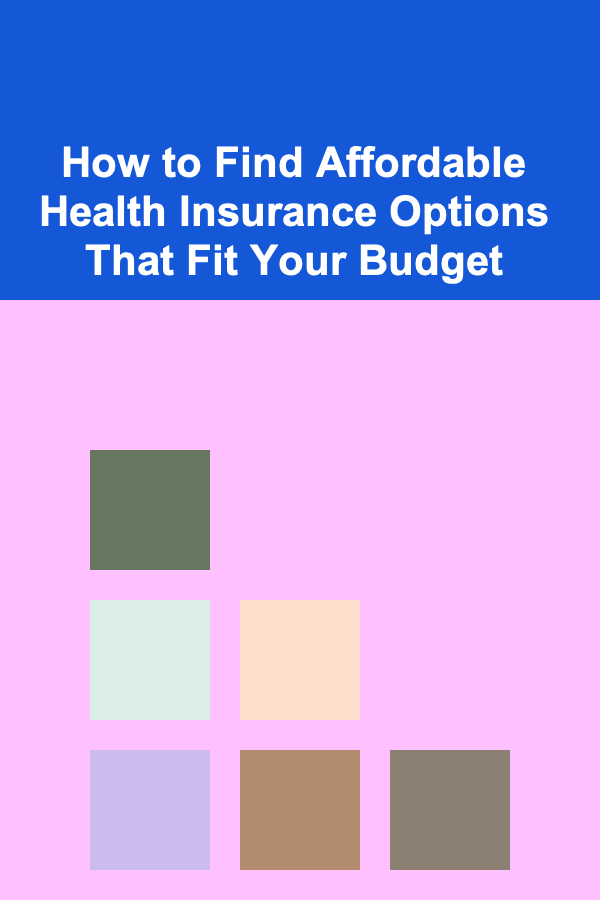
How to Find Affordable Health Insurance Options That Fit Your Budget
ebook include PDF & Audio bundle (Micro Guide)
$12.99$10.99
Limited Time Offer! Order within the next:

Finding affordable health insurance is an essential task for anyone looking to protect their health and avoid high medical costs. However, navigating the complex world of health insurance can be overwhelming, especially when you're trying to balance cost and coverage. This actionable guide will help you explore your options, identify cost-effective solutions, and find a plan that fits both your budget and your healthcare needs.
Understanding Your Health Insurance Needs
Before diving into the search for affordable health insurance options, it's important to assess your healthcare needs. Different people have different requirements, and understanding what you need will help you select the best plan for your situation. Consider the following factors:
- Your Health Status: If you're generally healthy and don't anticipate frequent medical visits, you may be able to choose a plan with higher deductibles and lower premiums. If you have chronic conditions or anticipate needing regular care, you may want a plan with lower out-of-pocket costs and broader coverage.
- Prescription Medications: If you take medications regularly, make sure your plan includes coverage for prescriptions. Some plans offer specific drug formularies, and the costs can vary widely based on your medication needs.
- Healthcare Providers: Do you have a preferred doctor or specialist? Make sure the plan you choose includes access to these providers. Some insurance plans are restricted to certain networks, while others allow you to see any doctor.
- Family Considerations: If you're insuring a family, you may want to look for family-friendly plans that provide coverage for dependents. Family plans can sometimes offer better value than individual plans if multiple family members need coverage.
Key Types of Health Insurance Plans
Understanding the different types of health insurance plans is essential for choosing the right one. Here are the most common types you'll encounter:
- Health Maintenance Organization (HMO): HMO plans tend to have lower premiums but require you to get care from a network of doctors and specialists. You'll need a referral from your primary care doctor to see a specialist.
- Preferred Provider Organization (PPO): PPO plans are more flexible, allowing you to see out-of-network providers, though at a higher cost. They also don't require referrals for specialists.
- Exclusive Provider Organization (EPO): EPOs are a middle ground between HMOs and PPOs. They typically offer a network of providers but do not require referrals. However, out-of-network care is not covered except in emergencies.
- High Deductible Health Plan (HDHP): These plans have higher deductibles and lower premiums. They're a good option if you're healthy and want to save on premiums, but you'll have to pay more out-of-pocket if you need care.
- Catastrophic Health Insurance: Catastrophic plans are designed for young, healthy individuals who don't anticipate needing much healthcare. They offer low premiums and high deductibles, primarily covering worst-case scenarios like accidents or serious illnesses.
- Marketplace Health Insurance: If you're in the U.S., you can shop for health insurance through the Health Insurance Marketplace. These plans are offered by private insurers but regulated by the government, with subsidies available for qualifying individuals.
Steps to Finding Affordable Health Insurance
Now that you understand your needs and the types of plans available, let's break down the steps for finding affordable health insurance.
1. Evaluate Your Budget and Plan for Premiums, Deductibles, and Co-pays
When selecting a health insurance plan, it's important to understand the total cost, not just the monthly premium. Premiums are the monthly payments you make to your insurer, but they're just one part of the equation. The following are additional costs to consider:
- Deductibles: The amount you must pay out-of-pocket before your insurance begins to cover costs. High-deductible plans have lower premiums but will cost you more in the event of medical care.
- Co-pays and Co-insurance: These are your share of medical costs. A co-pay is a fixed amount, while co-insurance is a percentage of the cost.
- Out-of-Pocket Maximum: This is the most you'll pay for covered services in a plan year. Once you reach this amount, your insurer will cover 100% of your care for the rest of the year.
A lower premium might seem attractive, but if it comes with a high deductible or high co-pays, it could end up costing you more in the long run. It's essential to balance these costs based on your healthcare needs.
2. Shop Around and Compare Plans
Use resources like the Health Insurance Marketplace (for U.S. residents) or state-based exchanges to shop for different health insurance plans. You can also look into private insurance providers. When comparing plans, pay attention to the following:
- Network: Ensure the plan includes your preferred healthcare providers and hospitals.
- Benefits and Coverage: Compare what each plan covers, including preventive care, mental health services, prescriptions, and specialist visits.
- Subsidies or Assistance Programs: Check if you qualify for subsidies, tax credits, or Medicaid (for low-income individuals) that can help make a plan more affordable.
3. Consider Government Subsidies and Assistance Programs
If you're in the United States and your income is below a certain threshold, you may qualify for subsidies through the Affordable Care Act (ACA). These subsidies can reduce the cost of premiums, deductibles, and out-of-pocket costs.
- Marketplace Subsidies: If your household income is between 100% and 400% of the federal poverty level, you may be eligible for a premium tax credit.
- Medicaid: Medicaid is a joint federal and state program that provides free or low-cost health coverage for low-income individuals and families.
- Children's Health Insurance Program (CHIP): CHIP provides health coverage to children in families that earn too much to qualify for Medicaid but cannot afford private coverage.
Even if you don't qualify for Medicaid or marketplace subsidies, you might be able to access state-specific programs designed to help lower-income residents.
4. Review Your Eligibility for Employer-Sponsored Health Insurance
If you're employed, check if your employer offers health insurance. Many employers provide health plans at a lower cost than individual plans, and some may even offer contributions toward your premiums.
- Employer Contributions: Employers often cover part of the premium, making it more affordable than purchasing insurance on your own.
- Open Enrollment: Make sure to enroll during the open enrollment period, as missing this window may limit your options.
5. Look Into Health Savings Accounts (HSAs) or Flexible Spending Accounts (FSAs)
If you have a high-deductible health plan (HDHP), you may be eligible for a Health Savings Account (HSA). An HSA allows you to save money tax-free for medical expenses, which can help offset the cost of higher deductibles.
- HSA: Contributions are tax-deductible, and withdrawals for qualifying medical expenses are tax-free.
- FSA: Similar to an HSA, but FSAs are often employer-sponsored and have a use-it-or-lose-it policy for funds at the end of the year.
Both HSAs and FSAs can be excellent tools for managing healthcare costs.
6. Consider Non-Traditional Health Insurance Options
If traditional insurance plans are too expensive, you might want to explore alternative options. Some non-traditional health insurance options include:
- Short-Term Health Plans: These plans provide temporary coverage, often at a lower cost, but they offer limited benefits and do not cover pre-existing conditions.
- Health Care Sharing Ministries: These are organizations where members share healthcare costs. While these are not technically insurance, they can be a more affordable way to manage healthcare expenses.
These options may not provide the same level of protection as traditional insurance but can serve as a viable short-term solution.
7. Consider Telemedicine and Preventive Care
Many health insurance plans now include telemedicine services, which allow you to consult with doctors remotely. Telemedicine is often more affordable than in-person visits, and it can be an excellent way to access care for non-emergency issues.
Additionally, look for plans that offer preventive care benefits at no extra cost. Many insurers cover screenings, vaccinations, and wellness visits as part of their plans, which can help reduce future healthcare costs.
Final Thoughts
Finding affordable health insurance is about more than just searching for the cheapest premium. By carefully evaluating your healthcare needs, comparing plans, and considering all your options, you can find a health insurance plan that fits your budget and provides the coverage you need.
Be proactive in exploring government assistance programs, employer-sponsored options, and non-traditional alternatives. And remember, health insurance is not a one-size-fits-all solution---it's about finding the right balance between cost and coverage that works for you and your family.
Reading More From Our Other Websites
- [Home Pet Care 101] How to Train a Dog to Use a Leash: Essential Tips for New Pet Owners
- [Weaving Tip 101] From Loom to Living Room: Transform Your Space with Hand-Woven Wall Hangings
- [Home Pet Care 101] How to Create a Pet-Friendly Cleaning Routine That's Safe and Effective
- [Organization Tip 101] The Ultimate Guide to Basement Waterproofing: Tips and Solutions
- [Organization Tip 101] Why You Should Utilize Wall Space for Better Organization
- [Stamp Making Tip 101] From Quill to Rubber: A Step-by-Step Guide to Creating Custom Calligraphy Stamps
- [Home Storage Solution 101] How to Organize Your Pantry with Easy and Affordable Solutions
- [Home Renovating 101] How to Design Your Dream Home During a Renovation
- [Home Holiday Decoration 101] How to Incorporate Vintage Holiday Decor into Modern Spaces
- [Personal Care Tips 101] How to Choose Lip Balm for a Soft, Plump Look

How To Master Video SEO for YouTube
Read More
How to Understand Accessibility in Graphic Design
Read More
How to Use Technology Mindfully in Your Daily Life
Read More
How to Use Portion Control for Weight Loss
Read More
How To Understand the Role of Mining in Crypto
Read More
How to Improve Your Credit Score with a Credit Card
Read MoreOther Products

How To Master Video SEO for YouTube
Read More
How to Understand Accessibility in Graphic Design
Read More
How to Use Technology Mindfully in Your Daily Life
Read More
How to Use Portion Control for Weight Loss
Read More
How To Understand the Role of Mining in Crypto
Read More